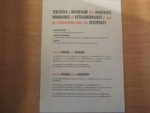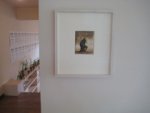RIGHT BEFORE SPRING with Lise DUCLAUX, Xavier MARTIN, Tinus VERMEERSCH
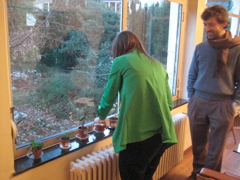
RIGHT BEFORE SPRING
Lise DUCLAUX, Xavier MARTIN, Tinus VERMEERSCH,
7 Mars 2009- 4 Avril 2009
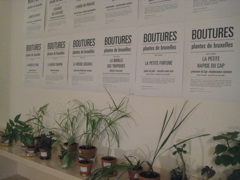
L’ Observatoire - maison Grégoire et Bn PROJECTS sont particulièrement heureux de vous présenter RIGHT BEFORE SPRING, émergences plastiques, un projet spécifique qui rassemble et confronte le temps d’une exposition pré-printanière des propositions de Lise DUCLAUX, Xavier MARTIN, Tinus VERMEERSCH.
La rencontre des pratiques d’un peintre, d’un dessinateur-sculpteur et d’une artiste qui investigue le vivant comme support et moyen d’expression de ses propositions et concepts pourrait apparaître à première vue comme surprenante dans l’écran architectural typé de cette maison moderniste qu’est la maison Grégoire.
loin de l’utilisation consacrée et légèrement galvaudée du mot dans les cénacles critiques , C’est sans doute par le terme d’émergence, dans son ’acception la plus directe et immédiate, que l’on saisit sans doute le mieux les résonances subtiles qui s’installent d’une proposition à l’autre.
Chacune de ces propositions participe d’un mouvement de résistance, d’affranchissement et d’irruption douce aux codes, aux courants, voire à leur support ou à leur contexte de monstration.
Lise Duclaux présente deux projets : L’un lancé en novembre dernier lors de l’expo 58T à bruxelles-Congrès (www.park58.be), s’intitule Plantes de Bruxelles : Lise au gré de ses promenades et rencontres bruxelloises a récolté, glané, subtilisé des boutures de plantes vivant dans la capitale qu’elle a dà »ment identifiées et rebaptisées. Il en résulte un protocole activé par le site internet de l’artiste (www.liseduclaux.be/plantesdebruxelles.html), où contre l’échange, je reprends ses termes, de la somme modique de vingt euros artiste et candidat-récipiendaire de la bouture se rencontrent et échangent l’un et l’autre des certificats « de vie et d’œuvre  », permettant à lise de garder une trace des profils de ces nouveaux compagnons de vie.
Le deuxième protocole lancé à l’occasion de cette exposition
se fonde sur un projet que Lise Duclaux a réalisé ces derniers mois au collège Jean Jaurès de Bourbourg (Nord-Pas-de-Calais).
Lise y a réalisé une « tentative d’inventaire des habitants ordinaires et extraordinaires du collège (…) en collaboration avec ses occupants  » . Se basant sur une réinterprétation des informations fournies par les occupants i.e. élèves et professeurs du collège, Lise a identifié, nommé, localisé, répertorié, cartographié et représenté les espèces vivantes, végétales et animales, de l’écosystème spécifique que constitue l’école. Et ce en faisant fi des hiérarchies usuelles : Monsieur Leroy, intendant de l’école, n’y est pas plus important que la coccinelle, l’ortie ou le nénuphar…
L’idée sous-tendant le protocole lancé pour right before spring est de proposer une convention de réalisation d’un inventaire du vivant à qui le souhaite : amateur, privé, institution, centre d’art, espace de vie ou de travail
Si les normes de classification (identification, localisation, détermination de l’origine) demeurent, La forme plastique de représentation qui sera in fine donnée à l’inventaire variera et sera agréée au cas par cas.
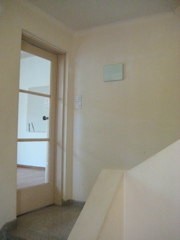
La révélation et l’irruption du vivant, récurrentes dans les propositions de lise Duclaux, trouvent une équivalence picturale dans l’œuvre picturale de Xavier Martin (Prix de la jeune Peinture Belge en 2003). C’est que les toiles qu’il présente ici ne sont monochromes et blanches qu’en apparence : de subtiles vibrations picturales et de légers accents chromatiques animent leur surface. On pressent la vie, le bouillonnement et l’agitation, la recherche et le labeur du peintre sous le glacis.
Ici, on n’oblitère que pour mieux laisser transpercer un élan indéfini, plein de promesses et de potentialités, à l’instar sans doute du cycle saisonnier de la vie.
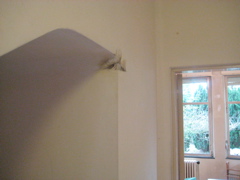
Les concepts de rémanence et de résistance caractérisent également, fà »t-ce d’une tout autre manière, le travail de Tinus Vermeersch.
L’univers de l’artiste gantois, qui pratique essentiellement le dessin et la sculpture, est parcouru par ces figures isolées de l’homme aux prises avec les éléments, comme absorbé dans un univers de conflits oniriques, mi-humains, mi-fantastiques.
Son langage est étonnamment classique (lavis, encre, plume) dans un style qui évoque tour à tour le dessin hollandais du XVIIe, l’univers surréaliste et la poétique du sublime.
L’échelle miniaturiste renforce à la fois l’étrangeté et la singularité de ses compositions et en accroît paradoxalement la force expressive, leur rémanence.
L’un des enjeux de l’invitation était de demander à Tinus d’investir directement l’espace moderniste de la maison Grégoire.
Faire œuvre de fresquiste-miniaturiste, dans l’un ou l’autre recoin ou repli intime de l’architecture.
Un contraste de plus pour affirmer l’expressivité de son vocabulaire.
Emmanuel Lambion
Vernissage le 4 Mars 2009, 19h.
Exposition ouverte les samedi de 14 Ã 18h., du 7/3/2009 au 04/04/2009
L’Observatoire-Maison Grégoire
292 Dieweg
B 1180 Bruxelles
observatoiregalerie@hotmail.com
RIGHT BEFORE SPRING
Lise DUCLAUX, Xavier MARTIN, Tinus VERMEERSCH,
7 March 2009- 4 April 2009
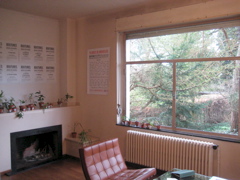
L’ Observatoire - maison Grégoire and Bn PROJECTS are particularly proud to present you RIGHT BEFORE SPRING,
an exhibition project confronting proposals by
Lise DUCLAUX, Xavier MARTIN, Tinus VERMEERSCH.
The confrontation of such distinctive practices (a painter, a draughtsman/sculptor and an artist who resorts to the living as a main way of expression of her concepts and proposals) in the confined, intimate and very characteristic setting of a house emblematic of the modernistic movement, might at first surprise more than one.
far from the somewhat « worn out  » acceptation of the expression in artistic circles, it is the topos of « emergent practices  » which might characterize the confrontations brought about by the project. It is indeed in a much more direct, straightforward and etymological understanding of the word that we use « emergent  » to qualify the intersections of these practices.
Each of these proposals somehow engages in a form of resistance. They also, symbolically or quite literally, hint at a sort of irruption through space, whether it be in a physical, aesthetic or architectural way.
Lise Duclaux presents two projects : The first was launched in November 2008, on the occasion of expo 58T at bruxelles-Congrès (www.park58.be) and is entitled Plantes de Bruxelles :
Through her many wanderings and encounters in the Belgian capital Lise duclaux has been gathering and collecting, sometimes at the limit of legality, number of cuttings from plants which live and proliferate in the Belgian capital.
Each cutting is carefully identified and re-baptised with a humorous name and when it is ready for a new life, a new environment, they are sold / made available by the artist through a specific web page (www.liseduclaux.be/plantesdebruxelles.html).
The protocol of the project has it that, on the conclusion of a transaction (each plant is sold for 20 euros), the artist and the candidate meet up to exchange certificates of « life and work  », which allows Lise to keep memory and trace of these new life companions.
The second protocol is currently launched for Right BEFORE SPRING.
It is based on a project carried out over the past few months in a school in Nord-PAS-de-Calais (F), the Lycée Jean Jaurès of the town of Bourbourg.
Lise realised an « attempt at making an inventory of the ordinary and extraordinary inhabitants of the school (…) in collaboration with it’s occupants  ».
She carefully collected and reinterpreted all the information that pupils and teachers could give her on the living species present in the school. Each species, both vegetal and animal (humans included) was thus identified, named, located, classified and mapped in a global cartography, before being individually drawn for an exhibition project in situ. The usual hierarchies and scale perspectives were left aside : Monsieur Leroy, the intendant of the school, was by no means more important than a nettle plant or a ladybird.
For right before spring, the idea is to adapt the idea underlying the Bourbourg project for further living or working spaces, whether it be that of private individuals, institutions, Art centres etc.
A convention is signed where the artist commits herself to carry out an inventory of the living for a given space environment.
If the norms and steps of the classification remain the same (identification, location, determination of the species through a series of visits of the premises and conversations with their occupants), the visual form given to the artistic representation of the final outcome of the research will vary and be agreed by the artist and the co-contractant.
The revelation and irruption of life in the proposals of lise Duclaux somehow find a pictorial echo in the works painted by Xavier Martin (jeune Peinture Belge Award in 2003).
The subtle pictorial vibrations and chromatic highlights of his paintings animate the surface of compositions which are white monochromes, only at a very hasty and superficial glance.
On closer inspection, one cannot but feel all the turmoil and agitation of life, the obstinate and sensitive labour of creation, under the candid surface of the canvas. The whiteness of the final glaze is there just to enhance the revelation of a vitality which cannot be stopped by the frost of an apparent pictorial respite. The « spring  » colour sap is never far away from the surface of the canvases.
The concepts of individual resiliency and resistance also characterize, albeit in a very distinctive way, the creations of Tinus Vermeersch. The world of this gent-based young artist, who resorts to draughtsmanship and sculpture as the main media of his practice, often show isolated human figures struggling against the elements, absorbed in a half fantastic, half-human atmosphere. His artistic vocabulary (ink, pen, and wash) is very classic, whilst the formal references alternatively hint at XVIIth century Dutch drawings, surrealism or at the romantic vision of the « sublime  ».
The often miniaturist scale of his compositions underlines their strange singularity, whilst highlighting their expressive strength and visual persistence in the mind of the beholder.
For this project, the challenge for Tinus was to infiltrate directly the modernist space of the house, exploiting the intimate corners of van de velde’s architecture.
A further contrast, as to express a sort of irruption of his singular practice and meant to enhance the expressivity of his vocabulary.
Emmanuel Lambion
Opening on Wednesday 4 March 2009, 7 p.m.
Exhibition open on Saturdays, 2-6 p.m., from 7/3/2009 until 04/04/2009
L’Observatoire Maison Grégoire
292 Dieweg
B 1180 Bruxelles
observatoiregalerie@hotmail.com
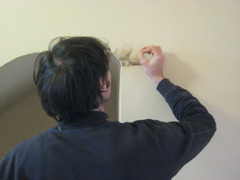
RIGHT BEFORE SPRING
Lise DUCLAUX, Xavier MARTIN, Tinus VERMEERSCH,
7 Maart 2009- 4 April 2009
L’ Observatoire - maison Grégoire en Bn PROJECTS zijn trots jullie RIGHT BEFORE SPRING te presenteren, Een tentoonstellingsproject met werk van Lise DUCLAUX, Xavier MARTIN, Tinus VERMEERSCH.
De confrontatie van uiteenlopende praktijken (een schilder, een tekenaar/beeldhouwer en een kunstenaar die haar toevlucht neemt tot het leven als voornaamste manier van expressie van haar concepten en voorstellen) in de beperkte, intieme en zeer karakteristieke setting van een huis, embleem van de modernistische beweging, werkt in de eerste plaats verrassend.
Ver weg van het enigzins “worn out†aanvaarden van expressie in artistieke kringen, is het de topos van “emergent practices†die de confrontatie in dit project karakteriseert. het is dan ook in een meer directe, ongecompliceerde en etymologische betekenis van het woord, dat we “emergent†gebruiken om de snijpunten van deze praktijken te benoemen. Elk van de voorstellen draagt op de een of andere manier een vorm van verzet in zich en duiden ook, symbolisch of vrij letterlijk, een binnendringen van de ruimte aan, of het nu op een fysische, esthetische of architecturele manier is.
Lise Duclaux presenteert twee projecten : het eerste, Plantes de Bruxelles, werd gelanceerd in november 2008 ter gelegenheid van expo 58t in brussel-congres (www.park58.be) : door haar vele tochten en ontmoetingen in de belgische hoofdstad verzamelde lise duclaux, soms op de grens van legaliteit, talrijke stekken van planten die voorkomen verspreid in de hoofdstad. Elke stek is zorgvuldig geïdentificeerd en her-doopt met een grappige naam, en wanneer ze klaar zijn voor een nieuw leven, een nieuwe omgeving, worden ze online aangeboden/verkocht door de artiest (www.liseduclaux.be/plantesdebruxelles.html).
Het protocol van het project schrijft het zo voor dat aan het eind van de transactie (elke plant wordt verkocht voor 20 euro), kunstenaar en kandidaat elkaar ontmoeten om certificaten van “life and work†uit te wisselen zodat lise een herinnering aan en spoor van de nieuwe levensgezellen kan bijhouden.
Het tweede werk werd gemaakt voor RIGHT BEFORE SPRING. Het is gebaseerd op een project dat de laatste paar maanden liep in een school in Nord-PAS-de-Calais (F), het Lycée Jean Jaurès in de stad Bourbourg. Lise ondernam een « attempt at making an inventory of the ordinary and extraordinary inhabitants of the school (…) in collaboration with it’s occupants  ». Ze verzamelde en herinterpreteerde zorgvuldig al de informatie die de leerlingen en leraars haar konden geven over de levende wezens aanwezig in de school. Elk wezen, zowel plant als dier (mensen inbegrepen) werd op die manier geïdentificeerd, Benoemd, gelocaliseerd, geklassificeerd en geplaatst in een globale cartografie, alvorens het elk apart getekend werd voor een tentoonstellingsproject in situ. De gebruikelijke hië rarchië n en schaalperspectieven liet ze links liggen : Monsieur Leroy, de schooldirecteur, was zo op geen enkele wijze belangrijker dan een brandnetel of een lieveheersbeestje.
Voor right before spring, is het idee om het uitgangspunt van het bourbourg project aan te passen voor andere leef- of werkruimtes, of het nu deze zijn van particulieren, instellingen, kunstencentra etc. Een conventie werd ondertekend waarin de kunstenaar zich ertoe bindt om een inventory of the living uit te voeren voor elke gegeven ruimtelijke omgeving. Ook al blijven de normen en stappen van klassificatie dezelfde (identificatie, localisering, determinatie van de specië n door een reeks van bezoeken van de ruimte en conversaties met hun bewoners), de visuele vorm van de artistieke presentatie van het resulaat van elk onderzoek varieert en wordt onderling overeengekomen tussen artieste en co-contractant.
De onthulling en doorsnede van het leven in het werk van lise duclaux vinden enigzins een picturale echo in de schilderwerken van Xavier Martin (jeune peinture belge award in 2003).
De subtiele picturale trillingen en kleurhoogtepunten van zijn schilderijen geven met één haastige en kunstmatige oogopslag leven aan het oppervlak van de composities, zijnde witte monochromen.
Na grondiger kijken, voel je onder dit oppervlak de chaos en onrust van het leven, de hardnekkige en gevoelige arbeid van creatie. Het witte van de laatst aangebrachte glans is er enkel om de onthulling te benadrukken van een vitaliteit die niet kan worden gestopt door het bevriezen van een ogenschijnlijke picturale verademing. De “lente†kleur is nooit ver weg van de canvasoppervlakken.
De concepten van individuele slagkracht en verzet karakteriseren ook, al is het op een zeer kenmerkende manier, de creaties van Tinus Vermeersch. De wereld van deze jonge kunstenaar uit Gent, die in zijn werk het tekenaarsschap en sculptuur als voornaamste media gebruikt, toont vaak geïsoleerde menselijke figuren die strijden tegen de natuurelementen, geäbsorbeerd in een halve fantasie-, half-menselijke atmosfeer. Zijn artistiek vocabularium (inkt, pen en was) is zeer klassiek, terwijl vormelijk referenties naar XVIIde-eeuwse nederlandse tekeningen doorschemeren, alsook het surrealisme en een romantische visie op het “sublieme†.
De vaak miniaturistische schaal van zijn composities onderlijnen hun vreemde eigenaardigheid en lichten een expressieve kracht en visuele hardnekkigheid uit in het gemoed van de aanschouwer.
Voor dit project was de uitdaging voor Tinus om de modernistische ruimte van het huis te infiltreren en intieme hoeken van van de velde’s architectuur te exploiteren. Een verder contrast, om zo een soort van binnendringen van zijn eigen praktijk uit te drukken, en bedoeld om de expressiviteit van zijn vocabularium te vergroten.
Emmanuel Lambion
Opening op Woensdag 4 Maart 2009, 19u
Expo open van 7/3/2009 tot 04/04/2009, op zaterdag van 14 tot 16u,
L’Observatoire Maison Grégoire
Dieweg 292
B 1180 Bruxelles
observatoiregalerie@hotmail.com
